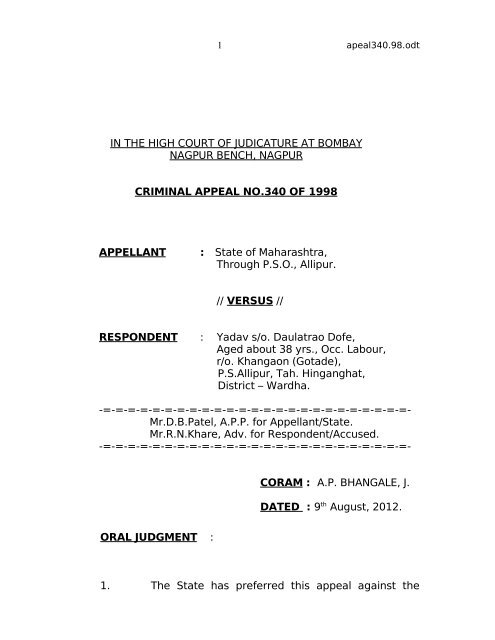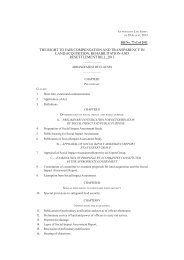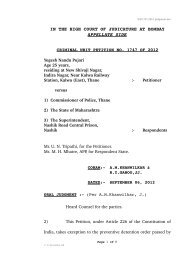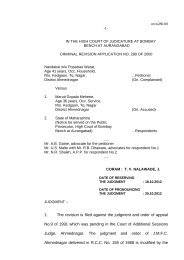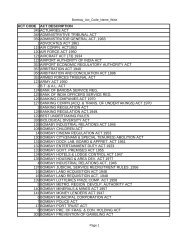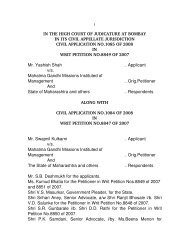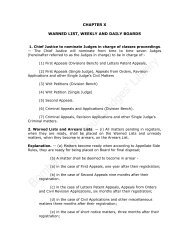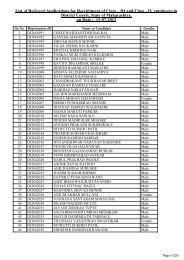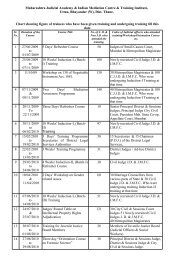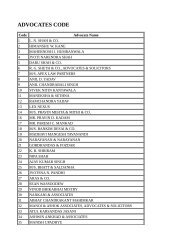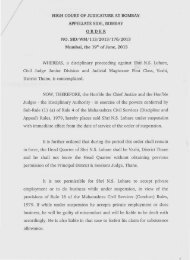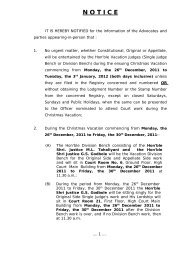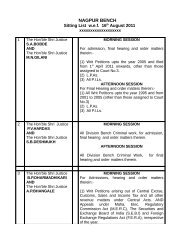State of Maharashtra - Bombay High Court
State of Maharashtra - Bombay High Court
State of Maharashtra - Bombay High Court
Create successful ePaper yourself
Turn your PDF publications into a flip-book with our unique Google optimized e-Paper software.
1 apeal340.98.odtIN THE HIGH COURT OF JUDICATURE AT BOMBAYNAGPUR BENCH, NAGPURCRIMINAL APPEAL NO.340 OF 1998APPELLANT: <strong>State</strong> <strong>of</strong> <strong>Maharashtra</strong>,Through P.S.O., Allipur.// VERSUS //RESPONDENT : Yadav s/o. Daulatrao D<strong>of</strong>e,Aged about 38 yrs., Occ. Labour,r/o. Khangaon (Gotade),P.S.Allipur, Tah. Hinganghat,District – Wardha.-=-=-=-=-=-=-=-=-=-=-=-=-=-=-=-=-=-=-=-=-=-=-=-=-=-Mr.D.B.Patel, A.P.P. for Appellant/<strong>State</strong>.Mr.R.N.Khare, Adv. for Respondent/Accused.-=-=-=-=-=-=-=-=-=-=-=-=-=-=-=-=-=-=-=-=-=-=-=-=-=-CORAM : A.P. BHANGALE, J.DATED : 9 th August, 2012.ORAL JUDGMENT :1. The <strong>State</strong> has preferred this appeal against the
2 apeal340.98.odtjudgment and order dated 25 th June, 1998 passed in SessionsTrial No.143 <strong>of</strong> 1994 delivered by the learned 2 nd AdditionalSessions Judge, Wardha whereby the respondent/accusedwas acquitted <strong>of</strong> the <strong>of</strong>fence punishable under Section 306 <strong>of</strong>the Indian Penal Code.2. The facts, briefly stated, are as under :Respondent/accused Yadav Daulatrao D<strong>of</strong>e,resident <strong>of</strong> village Khangaon, Tq.Hinganghat was a neighbour<strong>of</strong> Ashok Phasate (PW-4). It is alleged that deceased RekhaPhasate (wife <strong>of</strong> Ashok Phasate (PW-4) died since shecommitted suicide by pouring kerosene on her own body andsetting herself on fire. According to prosecution, her dyingdeclarations were recorded as per Exhs. 15 and 16. Shealleged in her dying declaration dt.25.3.1994 recorded atabout 1.30 p.m. that she was married prior to two years fromthe date <strong>of</strong> incident and has got one son, aged about 1 ½years. she and her husband were residing separately in theirresidential house where her mother-in-law and brother-in-lawwere residing. According to her, the respondent/accusedused to abuse her on consuming liquor and on 24.3.1994, atabout 6 O’ clock in the evening, when she had returned
3 apeal340.98.odthome after doing labour work, the respondent/accused, inthe absence <strong>of</strong> her husband, entered her house, gave abusesand threatened to kill her. He also caught hold <strong>of</strong> her hands,pushed and pulled her and dragged her out <strong>of</strong> the housewhen wife <strong>of</strong> accused Yadav rescued her. According to thedying declaration, because <strong>of</strong> this incident, victim Rekhawent inside the house, poured kerosene on her body and setherself on fire; while the respondent/accused extinguishedfire to some extent. She had sustained burns. However, shestated that she has no harassment from anybody in thehouse, but she was annoyed with respondent/accused.3. According to prosecution, the Executive Magistratehad also recorded dying declaration (Exh.15) which showsthat the accused used to quarrel with the victim daily and onthe relevant day, when the deceased came from the field inthe evening, she was beaten and abused in the absence <strong>of</strong>her husband. She got annoyed and she poured kerosene onher person and set herself on fire.According to dyingdeclaration (Exh.15), the victim had rushed straightway toaccused Yadav, who had extinguished the fire to someextent and sent her back home by pushing her. Thus, there
were two dying declarations.4 apeal340.98.odt4. Prosecution has examined six witnesses in support<strong>of</strong> the prosecution case. Dr. Jaichand Sakharamji Moon (PW-1) gave evidence regarding fitness certificate which he hasgranted regarding ability <strong>of</strong> injured Rekha to give herstatement.While Gorakhnath Namdeorao Ganvir is thePolice Constable who had recorded the dying declaration(Exh.16). Husband <strong>of</strong> the deceased namely Ashok UdhavPhusate was examined as PW-4. The doctor who conductedpost mortem over the dead body namely Dr.Meena w/o.Rajendra Daga is examined as PW-3, who deposed aboutcause <strong>of</strong> death as septicemic shock due to 77 % deep burns.The Investigating Officer Suresh Mahadeorao Lambat wasexamined as PW-5. Narayan Krushnaji Dhobale, the Tahsildarwho recorded the dying declaration (Exh.15) was examinedas PW-6. No defence evidence was led.5. In the impugned judgment and order, the learnedtrial Judge noted the submissions from the side <strong>of</strong> <strong>State</strong>regarding the allegations <strong>of</strong> mental torture from therespondent/accused, which is stated as a reason for
5 apeal340.98.odtcommission <strong>of</strong> suicide by the deceased. According to theprosecution, because on the date <strong>of</strong> incident modesty <strong>of</strong> thevictim was outraged, she decided to commit suicide. Thelearned trial Judge found discrepancies in the two dyingdeclarations viz. Exhs. 15 and 16. It appeared to him thatthe victim in both the dying declarations stated regardingthe assault being given to her by the accused and regardingoutraging <strong>of</strong> her modesty by the accused.While, accordingto witness Ashok (PW-4), a quarrel had taken place betweenRekha and respondent/accused eight days prior to theincident on account <strong>of</strong> fetching water and due to the saidquarrel, the victim had set herself on fire. But, in the course<strong>of</strong> examination-in-chief itself, he made a contrary statementas follows :“Mrs. Rekha was unable to speak. Hence, she did nottell me anything. “6. During the course <strong>of</strong> his cross-examination, Ashok(PW-4) also stated that Rekha was restless on the day <strong>of</strong>incident and could not speak. She started speaking 2 or 3days after her admission in the hospital. Witness Ashok (PW-
6 apeal340.98.odt4) was disowned by the prosecution and was crossexamined.Nothing is stated by witness Ashok as towhether the respondent/accused has outraged modesty <strong>of</strong>the deceased. According to the learned A.P.P., when crossexamined,Ashok has admitted that he stated before policeabout his statement that Rekha told him that accuseddragged her out <strong>of</strong> house and assaulted her. The contents <strong>of</strong>police statement were sought to be brought on record in thedeposition <strong>of</strong> witness Ashok by putting leading questions tohim as to what he had stated before police while givingstatement to the police. Such evidence would not be legallyadmissible in a criminal trial to prove <strong>of</strong>fence. Prosecution isexpected to lead evidence regarding guilt <strong>of</strong> the accusedbeyond all reasonable doubts and in accordance with law.7. Be that as it may, considering the legalrequirements <strong>of</strong> Section 306 r/w. Section 107 <strong>of</strong> the IndianPenal Code, it is apparent that the evidence must be crystalclear to indicate that there was an intention on the part <strong>of</strong>the accused to bring about the incident <strong>of</strong> suicide. Mens rea(guilty mind) is essential ingredient. The term “abetment”involves mental process to instigate a person or intentionally
7 apeal340.98.odtaid a person to commit suicide.It is a positive act toinstigate or aid in the commission <strong>of</strong> suicide. The evidencemust indicate that the victim was pushed into such aposition that the victim had no other option but to commitsuicide. There is no material in the present case to indicatethat, prior to commission <strong>of</strong> suicide, the respondent/accusedused any such utterance or words which led the deceased toend her own life by pouring kerosene on her body. Theevidence must indicate certain acts on the part <strong>of</strong> theaccused who allegedly abetted the deceased to commitsuicide. The acts may be in the form <strong>of</strong> instigation or anyintentional act or omission which, in fact, drove the victim tocommit suicide. The word “instigation” means to goad, urgeforward,provoke or encourage a victim to do an act i.e. tocommit suicide.8. In the present case, except quarrel and pushingand dragging etc. by the respondent/accused, no suchconcrete evidence is found which can be considered asproximate to commission <strong>of</strong> suicide or which can beconsidered as acts or omissions on the part <strong>of</strong> the accusedwhich led the victim to commit suicide with no other option.
8 apeal340.98.odtThe victim in the present case did not complain about anyharassment or cruelty against her husband or inlaws. Thealleged assault or pushing or dragging was imputed to theneighbour who had, in fact, tried to extinguish fire accordingto dying declaration itself. Therefore, one cannot say withconfidence that the respondent/accused was really involvedin the matter so as to instigate or aid deceased Rekha tocommit suicide. In a given case, it may happen that allegedvictim may be hypersensitive person to ordinary petulanceor discord or differences or quarrel in domestic life, whichare quite common in the society and if such person ends hisor her own life without any concrete material to attributecertain acts or omission on the part <strong>of</strong> the accused, theaccused cannot be blamed for a serious <strong>of</strong>fence like thatpunishable under Section 306 <strong>of</strong> the Indian Penal Code.Therefore, the learned trial Judge, who considered theevidence led by the prosecution, came to the logical andcorrect conclusion so as to acquit the respondent/accused.9. The <strong>High</strong> <strong>Court</strong> as a Appellate <strong>Court</strong> would notnormally interfere with an order <strong>of</strong> acquittal unless there isprima facie perversity in the judgment or compelling
9 apeal340.98.odtcircumstances. While, a reasoned judgment and order <strong>of</strong>acquittal ought not to be disturbed since the order <strong>of</strong>acquittal strengthens the presumption <strong>of</strong> innocence in favour<strong>of</strong> the accused throughout the trial. Interference by the <strong>High</strong><strong>Court</strong> is only called for if the findings given by the trial <strong>Court</strong>are perverse and contrary to the evidence on record or theentire approach <strong>of</strong> the trial <strong>Court</strong> was patently illegal leadingto miscarriage <strong>of</strong> justice or unreasonable judgment based onerroneous law and facts on record. And, under suchcircumstances only, the Appellate <strong>Court</strong> being a final <strong>Court</strong><strong>of</strong> facts is fully competent to re-appreciate, reconsider andreview the evidence and take its own decision keeping inmind that acquittal bolsters up presumption <strong>of</strong> innocence.For all the reasons afore-mentioned, no ground ismade out for interference in the appeal. Hence, the appeal isdismissed.jaisJUDGE


